
Deconstructing The Dram (from the Ardbeg tour)
There are many websites that explain how whisky is made and from what ingredients, so it isn't covered here. However, the flavours that contribute to the final dram are complex and originate from several sources.
Peat
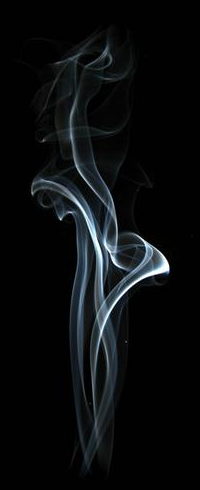
The first flavour is from the peat that is burnt under the malted barley to dry it out and to impart smokiness. Smoking can take from a few hours to several days depending upon the level of phenols required. The phenol level is measured in parts per million (ppm) and a low ppm grain would be perhaps up to 20ppm, a heavier ppm such as Ardbeg about 55ppm and a very heavy ppm such as Octomore would be of the order 150-170ppm. Some other examples are:
- Bunnahabhain - 1-2ppm
- Bruichladdich - 3-4ppm
- Caol Ila - 30-35ppm
- Port Charlotte - 40ppm
- Laphroaig - 40-43ppm
The whole of the barley grain is subsequently milled and used in the mash because the smoke is mostly absorbed by the husk and so it is an essential source of the smokiness. The chemical compounds in peat smoke have been analysed and are well understood and the following table shows the predominant chemicals and the different sensory attributes that they impart to the spirit.
| Compound | Sensory Attribute |
|---|---|
| 2-Methylphenol (o-Cresol) | Carbolic |
| 3-Methylphenol (m-Cresol) | Musty, medicinal |
| 4-Methylphenol (p-Cresol) | Medicinal |
| Dimethylphenols (Xylenols) | Medicinal, Sweet |
| 2-Methoxyphenol (Guaiacol or Cresol) | Medicinal, woody, smoky |
| 4-Ethylguaiacol | Spicy, meaty |
| 4-Vinylguaiacol | Spicy, clove |
| 4-(2-Propenyl)Guaiacol (Eugenol) | Cinnamon, spicy, clove |
Barrel
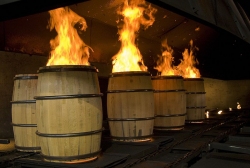
However, the final flavour comes not just from the peat smoke but also the barrel in which the spirit is matured. The barrel imparts its own attributes from the previous contents and, in the case of bourbon barrels, the level of charring too.
The charring process increases the inner surface area of the barrel so that there is more contact with the spirit and the depth of char is typically 3mm to 6mm. Most Bourbon makers generally use a number 3 char - designated #3 - which is on a scale from 1 (lightest) to 4 (darkest). Wild Turkey, Jim Beam and Willet prefer a #4 char. The charring used to be done by filling the barrel with straw and setting fire to it. These days a more consistent char is achieved using gas burners as shown here. The barrels have no heads at this stage and the hoops are temporary ones that are replaced with permanent hoops after the heads are fitted.
The charring times are typically: 15 seconds for #1, 30 seconds for #2, 35 seconds for #3 and 55 seconds for #4. Buffalo Trace has experimented with a #7 char at 3 ½ minutes - I'm surprised there's any barrel left!
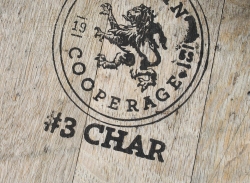
The level of charring affects the flavours that emerge from the wood. Heating the oak above 140°C causes the hemicellulose (plant cell walls to you and me) to decompose into wood sugars with flavours of toffee, brown sugar or caramel. Further heating causes the lignin to give out flavours of vanilla, spices and smoke. Although new barrels are seasoned before use to leach out the harsh tannins in the oak, some remain to a greater degree in low char barrels and to a lesser extent in high char barrels. Oak lactones are the fourth contributor to flavour, giving woody or coconut flavours in low char barrels but less so in high char barrels.
USA regulations state that bourbon barrels can only be used once so many barrels are dismantled and shipped to Scotland where they are reassembled into standard barrels or converted into quarter casks. Quarter casks are usually used to produce whisky more quickly due to the higher ratio of surface area to volume.
Maturation
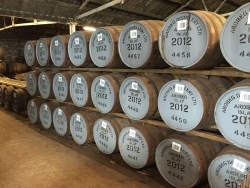
Although the bourbon barrels are empty before they are shipped, they still contain several litres of bourbon held within the wood. The colour and flavour of the bourbon are released gradually as the new spirit soaks into the wood and the cask expands and contracts with the humidity and temperature in the warehouse. It is this "breathing" that characterises the whisky so that the precise location and storage conditions can be important factors in maturation. It is known that different locations in the same warehouse can result in significant differences in otherwise identical whisky. It is for this reason that samples are taken at regular intervals so that the optimum maturation is achieved and the correct selection of casks made for subsequent mixing and bottling.
Finishing
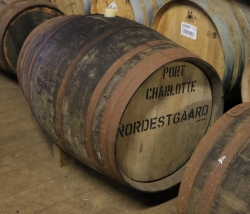
Finishing is the term given to transferring whisky from its original maturation cask into one of a different origin where it continues maturing for a relatively short period, perhaps three to twelve months. Typical finishing casks would include sherry, Sauvignon Blanc, port, red wine and rum. The finishing often creates a smoother whisky and almost always gives it a deeper colour. Sherry butts are becoming in short supply because of the decline in sherry drinking and, as a result, the purchase price to the distilleries has risen to upwards of £800 per butt. Although not an Islay distillery, Glenfiddich has recently tried maturing whisky in India Pale Ale (IPA) barrels.